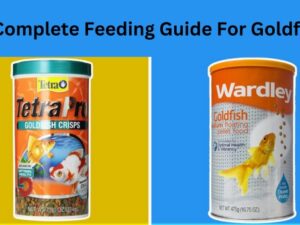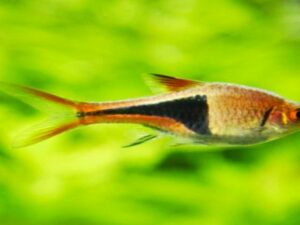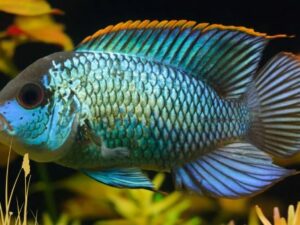The Copperband Butterflyfish (Chelmon rostratus) is a beautiful reef native to the tropical Indo-Pacific region. This stunning fish has a bright white body with yellow vertical bands and a long, elegant tail.
There are 129 fish related to the Copperband butterfly, including the Indian Butterflyfish, the raccoon butterflyfish, and the teardrop butterflyfish.
The Copperband butterfly is commonly found in saltwater reefs in the Indian and Pacific oceans around Indonesia, Australia, the Philippines, and Singapore.
Its natural habitat consists of corals and rocks at depths of up to about 98 feet (30 meters).
The Copperband Butterflyfish is a popular aquarium fish, but it can be challenging to care for due to its selective diet and delicate health if you are considering adding a Copperband Butterflyfish to your Aquarium, research and be prepared to provide the best care for this beautiful fish.
Table of Contents
Species Summary
| Scientific Name: | Chelmon rostratus |
| Common names: | Copper-banded Butterflyfish, beaked coralfish |
| Distribution: | The Pacific and Indian Ocean |
| Size: | 4-8 inches |
| Life expectancy: | 6-10 years |
| Color: | White with yellow bands |
| Diet: | Carnivore |
| Temperament: | Aggressive |
| Minimum tank size: | 75 gallons |
| Temperature: | 75°–84°F |
| pH: | 8.1–8.4 |
| Hardness: | 5–15 dGH |
| Care Level: | Moderate |
| Breeding: | Pelagic spawner |
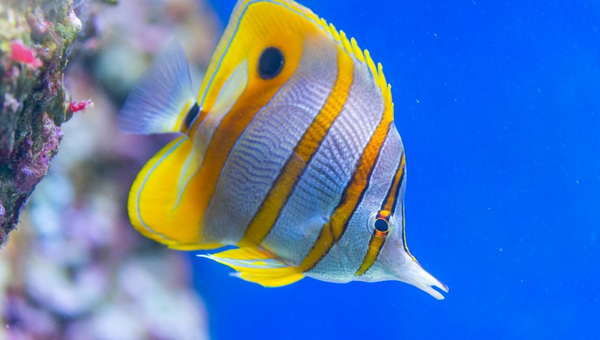
Copperband Butterflyfish Size and Growth Rate
Copperband Butterflyfish grow 4-6 inches long in captivity and up to 8 inches in the wild.
The male and females have no difference in their size.
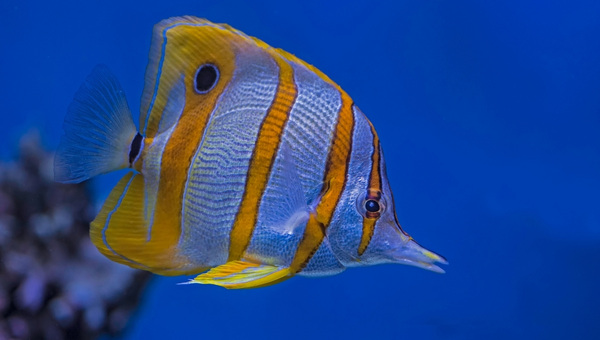
Copperband Butterflyfish Lifespan
In captivity, the average lifespan of a Copperband Butterflyfish is between 6-10 years, with the proper care. But they can live up to 12 years in the wild.
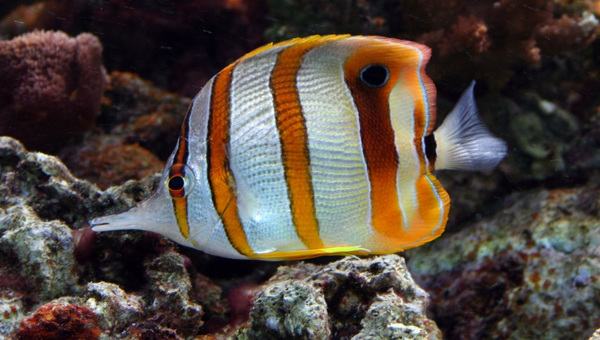
Also, check Panther Grouper Care Guide: Appearance, Lifespan & Coloration & Breeding
Copperband Butterflyfish Appearance
The Copperband Butterflyfish is a stunning fish with a vibrant white body and yellow vertical bands. Its long, elegant tail adds to its graceful appearance. The Copperband Butterflyfish has a long, narrow snout that is slightly upturned, giving it a beak-like appearance.
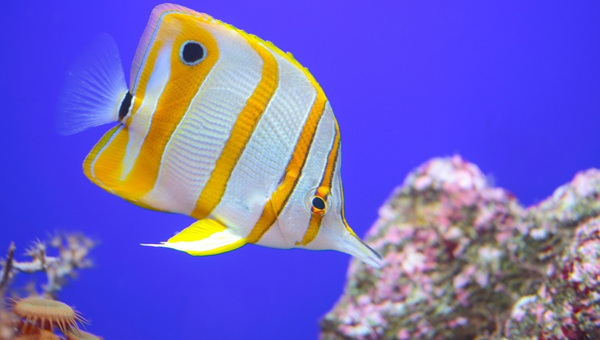
This snout is used to pick at small prey hidden among the coral. The Copperband Butterflyfish is peaceful but can be aggressive toward other fish with similar coloring or patterns.
Males and females look virtually identical. Males have more steeply-sloped snouts than females. Copperband butterflies look similar to margined coralfish, but margined coralfish have fewer stripes and darker colors.
Copperband Butterflyfish Behavior and Temperament
Copperband Butterflyfish are peaceful fish and make a great addition to any community tank.
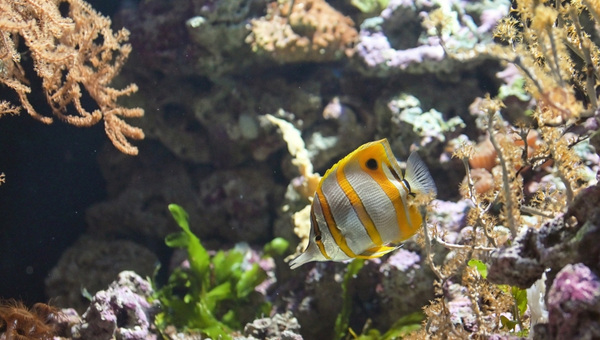
These fish get along well with other fish but may become aggressive towards smaller fish.
Copperband Butterflyfish Breeding
Breeding Copperband butterflies in captivity are complex and not recommended for beginners.
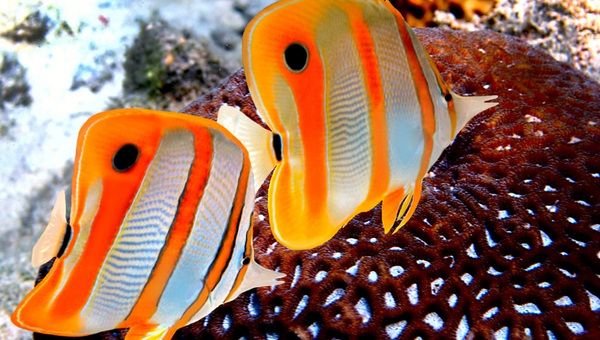
The female lays hundreds of eggs on the substrate. The male then fertilizes the eggs.
The fry hatch after about five days and free-swimming after another ten days. The fry is challenging to raise, requiring live food for sustenance.
If you're interested in breeding Copperband butterflies, it's best to consult an experienced breeder. Very few reports of successful breeding of the Copperband butterfly in captivity and little information about how to encourage the fish to mate.
Copperband Butterflyfish Care Guide
Copperband Butterflyfish are delicate fish that can be difficult to care for. They are picky and require a diet of live foods, such as brine shrimp, Mysis shrimp, and copepods. They will quickly starve to death if they do not receive enough food.
In addition, Copperband Butterflyfish are susceptible to diseases such as Marine White Spot Disease and Brooklynella. Copperband Butterflyfish are shy fish that do best in a peaceful aquarium with plenty of hiding places. They will likely become stressed and fall ill if kept with aggressive fish.
A minimum tank size of 75 gallons is recommended for Copperband Butterflyfish. The tank should have plenty of live rock and a sandy bottom for the fish to hide among. The water should be kept at a temperature of 75°–84°F, with a pH of 8.1-8.4 and a hardness of 5-15 dGH.
You may also check Bellus Angelfish Care: Appearance, Size, Lifespan, Diet & All.
Tank Size
The minimum tank size for a Copperband Butterflyfish is 75 gallons. Two Copperband butterflies require a tank of at least 125 gallons to prevent aggressive behavior between the fish.
Add a layer of sand, like aragonite sand or crushed coral, to the bottom of the tank. This will help maintain the water chemistry in the tank. Use corals and rocks to create a reef-like environment with lots of caves, cracks, and crevices for the fish to explore and claim as their territories.
Tank Conditions
The ideal tank conditions for copper and butterflies are:
- Water type: Alkaline, slow-moving saltwater
- Tank size: Minimum 75 gallons, or 125 gallons for two Copperband butterflies
- Water temperature: 75°–84°F
- Substrate: Fine sand or crushed coral
- Tank setup: Corals, rocks, caves
- Acidity: 8.1–8.4 pH
- Water hardness: 5–15 GH
- Filter: Yes, copper and butterflies are sensitive to water quality, and a filter will keep the water clean and clear
- Bubbler: Not necessary
- Pump: Yes, to provide water movement for gas exchange
- Lighting: Yes, to mimic the day-to-night cycles in the fish's natural habitat
- Water heater: Yes, to keep the water temperature in the mid-to-high seventies
Also, check Convict Cichlid Care: Best Detailed Guide
Water Parameter
Copperband Butterflyfish are very sensitive to water quality and changes in water parameters.
The ideal water parameters for copper and butterflies are:
- pH: 8.1-8.4
- Temperature:7 5°–84°F
- Ammonia: 0 ppm
- Nitrites: 0 ppm
- Nitrates: <20 ppm
- Phosphates: <0.5 ppm
- Magnesium: 1260-1350 ppm
- Calcium: 400-450 ppm
- Strontium: 8-10 ppm
Ensure that water's temperature, pH level, and hardness are well-maintained, and use a high-quality filter to keep the water clean.
Filtration
Copperband Butterflyfish are very sensitive to water quality and changes in water parameters. A sound filtration system is essential to maintain the water quality in the tank. The filter should handle at least ten times the tank's water volume.
Some commonly used filters are:
- Canister filters
- Power filters
- Hang-on-back (HOB) filters
- Undergravel filters
- Wet/dry filters
- Diatomaceous earth (DE) filters
- Reverse osmosis (RO) filters
The filter should be able to remove ammonia, nitrites, and nitrates from the water. A protein skimmer is also recommended to remove organic waste from the water.
Check 9 Best Types of Freshwater Aquarium Catfish
Protein Skimmer
A protein skimmer is a mechanical filtration device that removes organic waste from the water. Protein skimmers create a foam of bubbles that attract and trap organic debris. The waste is then collected in a cup or chamber and can be removed from the tank.
Protein skimmers are essential to keeping a saltwater aquarium because they remove organic waste before it can decompose and pollute the water. Protein skimmers also help to oxygenate the water and remove harmful chemicals, such as ammonia and nitrites.
Types of Protein Skimmers:
- Air-driven protein skimmers
- Water-driven protein skimmers
An air pump powers air-driven protein skimmers, and a venturi valve creates bubbles. Water-driven protein skimmers use a water pump to create bubbles.
Protein skimmers come in all different shapes and sizes. Some protein skimmers are placed inside the Aquarium, while others are designed to be outside the Aquarium.
Check Butterfly Betta Care Guide: Appearance, food & Diet, Breeding & All
Heating
A water heater is necessary to maintain the temperature in the mid-to-high seventies. Copperband Butterflyfish are very sensitive to changes in water temperature and will become stressed if the water temperature drops too low.
Water heaters come in all different shapes and sizes. Some water heaters are placed inside the Aquarium, while others are designed to be outside the Aquarium.
Some commonly used heaters are:
- Submersible heaters
- Immersible heaters
- Undergravel heaters
- Hang-on-the-back (HOB) heaters
- Inline heaters
Water heaters are available in a variety of wattages to suit different-sized aquariums. Choosing a water heater that is the correct size for the Aquarium is essential.
Lighting
Copperband Butterflyfish are sensitive to light and need a day-night cycle to feel comfortable in their environment. The lighting in the Aquarium should mimic the day-night process in the fish's natural habitat.
Some commonly used lighting fixtures are:
- Fluorescent lights
- LED lights
- Halogen lights
- Incandescent lights
Lighting fixtures come in all different shapes and sizes. Some lighting fixtures are placed inside the Aquarium, while others are designed to be placed outside the Aquarium.
The type of lighting fixture you choose will depend on the size of your Aquarium and the kind of fish you keep.
Also, check Panther Grouper Care Guide: Appearance, Lifespan & Coloration & Breeding
Decoration
Copperband Butterflyfish need plenty of hiding places and do not like open spaces. The Aquarium should be decorated with live rock, coral, or other decorations that provide hiding places for the fish. The fish will also appreciate some plants in the Aquarium.
Some commonly used plants are:
- Java fern
- Anubias
- Bolbitis
- Cryptocoryne
Some commonly used decorations are:
- Live rock
- Coral
- Artificial plants
- Pipes
- Tubes
- Hides
The type of decoration you choose will depend on the size of your Aquarium and the kind of fish you keep.
Cleaning the tank
You should perform a partial water change of 25% every other week. You will also need to vacuum the gravel and clean the filter media. Rinse the filter media in old tank water to prevent disrupting the beneficial bacteria colony.
To clean the tank, you will need the following:
- A sponge: A sponge can be used to wipe down the inside of the tank.
- A toothbrush: bA toothbrush can be used to clean the filter.
- Freshwater: You will need fresh water to rinse off the sponge and toothbrush.
The steps for cleaning the tank are as follows:
- Remove the fish from the tank and put them in a temporary home.
- Remove all of the decorations from the tank.
- Use the sponge to wipe down the inside of the tank.
- Rinse the sponge and toothbrush with fresh water.
- Use the toothbrush to clean the filter.
- Rinse the sponge and toothbrush with fresh water.
- Add the decorations back to the tank.
- Add the fish back to the tank.
It is essential to clean the tank regularly to prevent the build-up of algae and bacteria. Algae and bacteria can be harmful to fish, and they can also cause the water to become cloudy.
Check Ultimate Dragon Goby 101: Care, Appearance, Food, Habitat & All
Cleaning The Filter
It is essential to clean your filter regularly. A dirty filter can cause problems for your fish.
To clean your filter, you will need the following:
- A clean bucket: This is used to hold the old water.
- A garden hose: This is used to rinse the filter media.
- Filter media: This is used to replace the old media.
Common Possible Diseases
There are some common diseases are mentioned below:
- Fin Rot: Fin rot is a disease that can affect fish fins. The condition is caused by bacteria, which can be deadly if left untreated.
Symptoms of fin rot include:
- Blackened or frayed fins
- Reduced appetite
- Lethargy
If you notice these symptoms in your fish, you should take them to a vet for treatment.
- Dropsy: Dropsy is a disease that can affect fish's internal organs. Bacteria cause the disease, and it can be deadly if left untreated.
Symptoms of dropsy include:
- Bloated body
- Elevated scales
- Lethargy
If you notice these symptoms in your fish, you should take them to a vet for treatment.
- Ich: Ich is a disease that can affect the skin of fish. Parasites cause the disease, and it can be deadly if left untreated.
Symptoms of ich include:
- White spots on the skin
- Flashing
- Scratching
If you notice these symptoms in your fish, you should take them to a vet for treatment.
Also, check Clown Loach Care: Appearance, Tank Mates, Lifespan, Breeding & All
Treating Disease
If you think your fish may be sick, the best thing to do is take them to a vet. A vet can diagnose the disease and prescribe the appropriate treatment.
Preventing Disease
The best way to prevent disease is to maintain a clean and healthy environment for your fish.
You should perform regular water changes and clean the tank regularly. You should also avoid overfeeding your fish.
Copperband Butterflyfish Food and Diet
Copperband Butterflyfish are mainly carnivores, and their diet should consist of meat and sometimes plants, but these are difficult to feed, especially when first introduced to the tank. Stressed or nervous fish often refuse to provide.
- You can feed your fish live food, frozen food, or pellets.
- Some good options for live food include brine shrimp, bloodworms, and daphnia.
- Some good options for frozen food include krill, shrimp, and Mysis shrimp.
- Some good options for pellets include spirulina pellets, algae pellets, and bloodworm pellets.
Feed them high-protein, mineral-fortified pellets three times per week to ensure the fish's nutritional needs are met. It would be best to feed your fish 2-3 times daily. Don't overfeed your fish because this stresses the fish's digestive system. Keep the water as clean as possible — Copperband butterflies are likelier to eat in high-quality water conditions.
Also, check Jaguar Cichlids Care: Appearance, Lifespan
Copperband Butterflyfish Tank Mates
Some good tank mates for Copperband Butterflyfish include:
Don't house Copperband butterflies with other species of Butterflyfish because the fish exhibit aggressive and territorial behavior toward one another. Invertebrates aren't good tank mates for these fish because they feed on invertebrates in the wild.
Some other fish that should be avoided include:
- Triggerfish
- Pufferfish
- Dotty backs
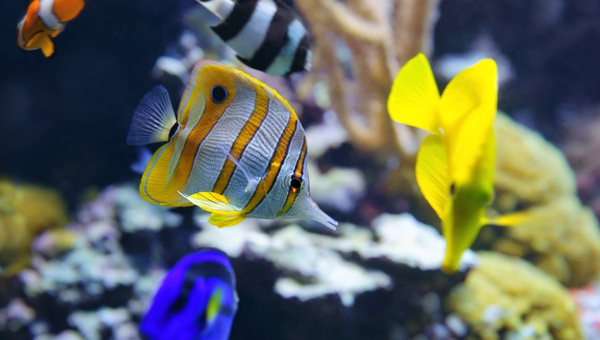
Advantages Of Having Copperband Butterflyfish In Your Tank
Copperband Butterflyfish are beautiful fish that make a great addition to any community tank. These fish are peaceful and get along well with other fish but may become aggressive towards smaller fish.
Copperband Butterflyfish are also difficult to breed in captivity, so having them in your tank can be a real challenge. These fish are not for beginners, but if you're up for the challenge, they can be a great addition to your home aquarium.
Disadvantages Of Having Copperband Butterflyfish In Your Tank
The most significant disadvantage of having Copperband Butterflyfish in your tank is that they're difficult to care for. These fish are sensitive to water quality changes and are also known to be fussy eaters.
If you're not prepared to dedicate the time and effort to care for these fish, it's best to avoid them.
Also, check Silver Dollar Fish 101: Care, Diet, Appearance, Breeding & All
Conclusion
If you're an experienced aquarium keeper and up for the challenge, a Copperband Butterflyfish can be a great addition to your tank. These fish are beautiful and relatively peaceful, but they require extra care.
Don't get a Copperband butterfly if your existing tank contains incompatible fish or you don't want to care for a high-maintenance fish with known feeding issues.
Despite their high care needs, these fish are colorful, exciting fish that is enjoyable to watch in a home aquarium. If you're a beginner, it's best to avoid these fish. Plenty of other, easier-to-care-for fish would make a better choice for a beginner aquarium keeper.

